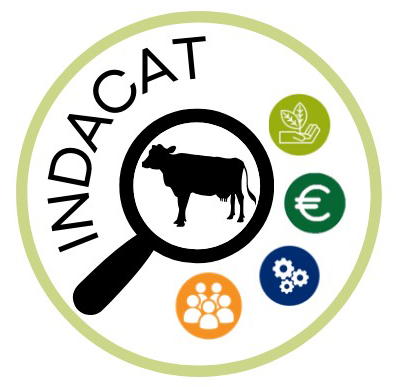INDACAT | INstructions from PLF Data Analysis to improve the CATtle farming
In questa pagina

Scientific Referent
Working group
Matteo Barbari, Gianluca Bambi, Sebastian Schweizer
Project partners
Università degli Studi di Milano
Università degli Studi di Bologna
Università degli Studi di Catania
Main objectives
In line with the objectives of the European Green Deal, implemented in Italy with the National Plan for Recovery and Resilience (PNRR), there is a growing need for actions to make food production more sustainable, less harmful to the environment and guaranteed to all European citizens. In particular, PNRR point “M2C1 - Sustainable agriculture and circular economy” aims to develop a sustainable agri-food chain, improving the environmental performance and competitiveness of farms.
Considering that the livestock sector, and in particular the cattle one, is responsible for a wide share of GHG emissions from the agri-food chain (e.g., methane from enteric fermentation and nitrous oxide from manure storage and management) and that there is still a wide space for improvement in the livestock farms performances, the project INDACAT fits well in the PNRR objectives. INDACAT aims to adopt Precision Livestock Farming (PLF) tools to monitor cows continuously under multiple aspects of the whole cattle chain. Each research unit involved will focus on one aspect of cattle farming, and in particular:
- on the barn environment of intensive and organic dairy cattle farms, by monitoring micro-climatic parameters and air quality and adopting data science techniques to model, predict and automatically modify the parameters of the barns in view of improved animals’ welfare,
- on the extensive systems, by monitoring cows’ grazing activities with GIS and IoT technology to identify the spatial position and to make assessments about the grazing activity, feed intake and use of grazing areas (and the related soil degradation) both of dairy cows and cows of the calf-cow line,
- on the social behavior and interactions among cows, by evaluating their behaviors to understand their activities and relationships in view of heat detection, the definition of (re)groupings, detection and/or transmission of diseases, spatial distribution during grazing, health and welfare issues,
- on the growth and weaning of calves, by monitoring calves from their birth to identify an optimal weaning technique that improves animals’ growth, health and welfare finally leading to improved performances in cow ages, and to im-prove knowledge on calves by using technology and data science.
Through INDACAT, overall efficiency improvements will be achieved and will permit the development of a resource-efficient and competitive livestock sector, with positive impacts on the environment, society, and animals’ health and welfare. Farms digitalization will be a key point because the potentialities of PLF (use of sensors, technology, IoT and data science) are huge and widely recognized. By acting on a wide spectrum of cattle livestock aspects, INDACAT will show the potentialities of PLF and data analysis and will clarify how innovation and digitalization can improve the com-petitiveness, sustainability, animal welfare, health and productivity of farms.
Abstract
UNIFI research unit has this specific role: Develop and test novel automated tools to monitor social interactions among dairy cattle.
The main methodological phases and results include:
- animal movement and social dynamics data will be collected using accelerometers, positioning sensors and proximity loggers. Proximity loggers are active Radio-Frequency Identification (RFID)-based sensors capable of detecting close colocation of the sensors to be used as a proxy for dyadic social interactions;
- predictions based on sensor data will be validated against direct observations by trained observers;
- a methodological framework based on social network analysis and machine learning algorithms will be developed to study cattle social behaviour and relationships with productivity, health, management and sustainability. As a knowledge gap exists about social dynamics in dairy cattle, the proposed project has the potential to produce a significant impact in the field of animal science. Further, automated measurement of cows’ interactions can be expected to yield information to practical farm management. A few examples of such practical applications and the related key points analysed in the project are:
- heat detection. Oestrus-related behaviours in cattle include a wide range of activities that involve interactions with herd mates (Reith, 2018). Therefore, quantitative assessment of interactions can be used for heat detection;
- cattle (re)grouping. It is well documented that grouping of unfamiliar animals increases aggression, social stress and may have negative effects on feed intake and milk yield (von Keyserlingk, 2008). Increased knowledge about social dynamics has great potential to improve (re)grouping strategies in dairy operations;
- disease prevention and detection. Changes in cattle social behaviour might indicate impaired health. Various associations have been found between social behaviour of cows and lameness. Lame cows have been reported to have less agonistic interactions than non-lame cows (Galindo 2002). Also, the survival rate to lameness for low-ranking cows was found significantly lower than for middle- or high-ranking individuals. Social behaviour measurements can improve both prevention and treatment of lameness in dairy cows;
- grazing and pasture management. Cattle' social relationships influence grazing distribution and pasture use. Research suggests that dominance-related behaviour can impact herbage intake and milk production in grazing animals (Phillips, 2002). Automatic measurements of social behaviour can improve management in pasture-based dairy systems;
- disease transmission. Several infectious diseases are transmitted among individuals during close contact. Monitoring interactions among cows can help understand the transmission pathways of disease;
- animal welfare. Gaining insights into dairy cattle social dynamics may have important connections with animal welfare and its assessment. To date, few studies provided information on valid, reliable, and feasible indicators to address positive aspects of animal welfare. Social behavior may be a functional indicator of the well-being of individual cows as affiliative behavior has been proposed as a positive welfare marker (Mattiello, 2019). Studying social behavior can help understand the personality traits of dairy cows that may have implications for the development of a futuristic “personalized” approach to dairy cattle management.
Duration
Inizio: 12/10/2023
Conclusione: 12/10/2025
Funding body
Web site
Ultimo aggiornamento
07.05.2024
